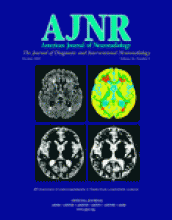Research ArticleINTERVENTIONAL
Correlation between Lumenal Geometry Changes and Hemodynamics in Fusiform Intracranial Aneurysms
Liang-Der Jou, Gregory Wong, Brad Dispensa, Michael T. Lawton, Randall T. Higashida, William L. Young and David Saloner
American Journal of Neuroradiology October 2005, 26 (9) 2357-2363;
Liang-Der Jou
Gregory Wong
Brad Dispensa
Michael T. Lawton
Randall T. Higashida
William L. Young

References
- ↵Hassan T, Ezura M, Timofeev EV, et al. Computational simulation of therapeutic parent artery occlusion to treat giant vertebrobasilar aneurysm. AJNR Am J Neuroradiol 2004;25:63–68
- ↵
- ↵Lieber B, Gounis M. The physics of endoluminal stenting in the treatment of cerebrovascular aneurysms. Neurol Res 2002;24:S33–S42
- ↵Hoi Y, Meng H, Woodward SH, et al. Effects of arterial geometry on aneurysm growth: three-dimensional computational fluid dynamics study. J Neurosurg 2004;101:676–681
- ↵Steinman DA, Milner JS, Norley CJ, et al. Image-based computational simulation of flow dynamics in a giant aneurysm. AJNR Am J Neuroradiol 2003;24:559–566
- Foutrakis GN, Burgreen G, Yonas H, Sclabassi RJ. Construction of 3-D arterial volume meshes from magnetic resonance angiography. Neurol Res 1996;18:354–360
- ↵Jou LD, Quick CM, Young WL, et al. A computational approach to quantifying hemodynamic stress in giant cerebral aneurysms. AJNR Am J Neuroradiol 2003;24:1804–1810
- ↵
- Long Q, Xu XY, Collins MW, Bourne M, Griffith TM. Magnetic resonance image processing and structured grid generation of a human abdominal bifurcation. Comput Methods Programs Biomed 1998;56:249–259
- ↵Long Q, Ariff B, Zhao SZ, et al. Reproducibility study of 3D geometrical reconstruction of the human carotid bifurcation from magnetic resonance images. Magn Reson Med 2003;49:665–674
- ↵Toth M, Nadasy GL, Nyar I, et al. Are there systemic changes in the arterial biomechanics of intracranial aneurysm patients? Pflugers Arch 2000;439:573–578
- ↵
- ↵Perktold K, Rappitsch G. Computer simulation of local blood flow and vessel mechanics in a compliant carotid artery bifurcation model. J Biomech 1995;28:845–56
- ↵San Millan Ruiz D, Tokunaga K, Dehdashti AR, et al. Is the rupture of cerebral berry aneurysms influenced by the perianeurysmal environment? Acta Neurochir 2002;82:31–34
- ↵Seshaiyer P, Humphrey JD. On the potentially protective role of contact constraints on saccular aneurysms. J Biomech 2001;34:607–612
- ↵Chen S. Molecular and mechanical bases of focal lipid accumulation in arterial wall. Progr Biophys Mol Biol 2003;83:131–151
- ↵Resnick N, Yahav H, Shay-Salit A, et al. Fluid shear stress and the vascular endothelium: for better and for worse. Prog Biophys Mol Biol 2003;81:177–199
- Sho E, Sho M, Singh TM, et al. Blood flow decrease induces apoptosis of endothelial cells in previously dilated arteries resulting from chronic high blood flow. Arterioscler Thromb Vasc Biol 2001;21:1139–1145
- ↵Sho E, Nanjo H, Sho M, et al. Arterial enlargement, tortuosity, and intimal thickening in response to sequential exposure to high and low wall shear stress. J Vasc Surg 2004;39:601–612
- ↵Kondo S, Hashimoto N, Kikuchi H, et al. Apotosis of medial smooth muscle cells in the development of saccular cerebral aneurysms in rats. Stroke 1998;29:181–189
- ↵Shojima M, Oshima M, Takagi K, et al. Magnitude and role of wall shear stress on cerebral aneurysm: computational fluid dynamic study of 20 middle cerebral artery aneurysms. Stroke 2004;35:2500–2505
- ↵Vates GE, Auguste KI, Lawton ML. Fusiform, dolichoectatic, and dissecting aneurysms: diagnosis and management. In: Management of cerebral aneurysms. Le Roux PD, Winn HR, Newell DW, eds. Philadelphia: Saunders;2004 :689–710
- ↵Davies PF. Flow-mediated endothelial mechanotransduction. Physiol Rev 1995;75:519–560
- ↵Malek AM, Alper SL, Izumo S. Hemodynamic shear stress and its role in atherosclerosis. JAMA 1999;282:2035–2042
- ↵Nakatomi H, Segawa H, Kurate A, et al. Clinicopathological study of intracranial fusiform and dolichoectatic aneurysms: insight on the mechanism of growth. Stroke 2000;31:896–900
In this issue
Advertisement
Liang-Der Jou, Gregory Wong, Brad Dispensa, Michael T. Lawton, Randall T. Higashida, William L. Young, David Saloner
Correlation between Lumenal Geometry Changes and Hemodynamics in Fusiform Intracranial Aneurysms
American Journal of Neuroradiology Oct 2005, 26 (9) 2357-2363;
0 Responses
Jump to section
Related Articles
- No related articles found.
Cited By...
- CFD: Computational Fluid Dynamics or Confounding Factor Dissemination? The Role of Hemodynamics in Intracranial Aneurysm Rupture Risk Assessment
- Computational Fluid Dynamics in Aneurysm Research: Critical Reflections, Future Directions
- Effects of Perianeurysmal Environment during the Growth of Cerebral Aneurysms: A Case Study
- Determination of Wall Tension in Cerebral Artery Aneurysms by Numerical Simulation
- Aneurysm Growth Occurs at Region of Low Wall Shear Stress: Patient-Specific Correlation of Hemodynamics and Growth in a Longitudinal Study
- Dilation-Dependent Activation of Platelets and Prothrombin in Human Thoracic Ascending Aortic Aneurysm
This article has not yet been cited by articles in journals that are participating in Crossref Cited-by Linking.
More in this TOC Section
Similar Articles
Advertisement











